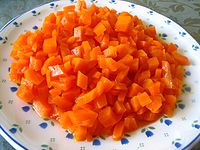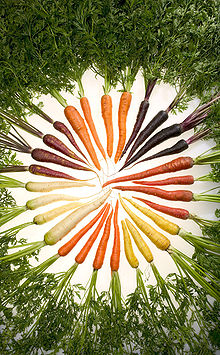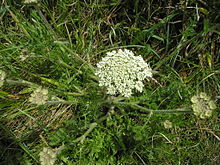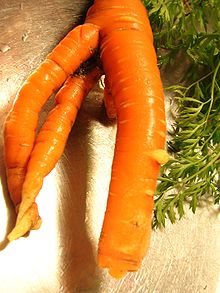- Carrot
-
This article is about the cultivated vegetable. For other uses, see Carrot (disambiguation).
Carrot 
Harvested carrots Scientific classification Kingdom: Plantae (unranked): Angiosperms (unranked): Eudicots (unranked): Asterids Order: Apiales Family: Apiaceae Genus: Daucus Species: D. carota Binomial name Daucus carota
L.The carrot (Daucus carota subsp. sativus, Etymology: Middle French carotte, from Late Latin carōta, from Greek καρότον karōton, originally from the Indo-European root ker- (horn), due to its horn-like shape) is a root vegetable, usually orange in colour, though purple, red, white, and yellow varieties exist. It has a crisp texture when fresh. The most commonly eaten part of a carrot is a taproot, although the greens are edible as well. It is a domesticated form of the wild carrot Daucus carota, native to Europe and southwestern Asia. The domestic carrot has been selectively bred for its greatly enlarged and more palatable, less woody-textured edible taproot.
Contents
Description
It is a biennial plant which grows a rosette of leaves in the spring and summer, while building up the stout taproot, which stores large amounts of sugars for the plant to flower in the second year. The flowering stem grows to about 1 metre (3 ft) tall, with an umbel of white flowers that produce a fruit called a mericarp by botanists, which is a type of schizocarp.[1]
Methods of consumption and uses
Carrot, raw Nutritional value per 100 g (3.5 oz) Energy 173 kJ (41 kcal) Carbohydrates 9 g - Sugars 5 g - Dietary fibre 3 g Fat 0.2 g Protein 1 g Vitamin A equiv. 835 μg (104%) - beta-carotene 8285 μg (77%) - lutein and zeaxanthin 256 μg Thiamine (vit. B1) 0.04 mg (3%) Riboflavin (vit. B2) 0.05 mg (4%) Niacin (vit. B3) 1.2 mg (8%) Vitamin B6 0.1 mg (8%) Folate (vit. B9) 19 μg (5%) Vitamin C 7 mg (8%) Calcium 33 mg (3%) Iron 0.66 mg (5%) Magnesium 18 mg (5%) Phosphorus 35 mg (5%) Potassium 240 mg (5%) Sodium 2.4 mg (0%) Percentages are relative to US recommendations for adults. Carrots can be eaten in a variety of ways. Only 3% of the β-carotene in raw carrots is released during digestion: this can be improved to 39% by pulping, cooking and adding cooking oil.[2] Alternatively they may be chopped and boiled, fried or steamed, and cooked in soups and stews, as well as baby and pet foods. A well known dish is carrots julienne. Grated carrots are used in carrot cakes, as well as carrot puddings, an old English dish thought to have originated in the early 19th century. The greens are edible as a leaf vegetable, but are rarely eaten by humans. Together with onion and celery, carrots are one of the primary vegetables used in a mirepoix to make various broths.
In India carrots are used in a variety of ways, as salads or as vegetables added to spicy rice or daal dishes. The most popular variation in north India is the Gaajar Kaa Halwaa carrot dessert, which has carrots grated and cooked in milk until the whole mixture is solid, after which nuts and butter are added. Carrot salads are usually made with grated carrots in western parts with a seasoning of mustard seeds and green chillies popped in hot oil, while adding carrots to rice usually is in julienne shape.
The variety of carrot found in north India is rare everywhere except in Central Asia and other contiguous regions, and is now growing in popularity in larger cosmopolitan cities in South India. The north Indian carrot is pink-red comparable to plum or raspberry or deep red apple in colour (without a touch of yellow or blue) while most other carrot varieties in world are from orange to yellow in colour, comparable to hallowe'en pumpkins.
Ever since the late 1980s, baby carrots or mini-carrots (carrots that have been peeled and cut into uniform cylinders) have been a popular ready-to-eat snack food available in many supermarkets.
Carrot juice is also widely marketed, especially as a health drink, either stand-alone or blended with fruits and other vegetables.
Companion plant
Carrots are useful companion plants for gardeners. There is experimental evidence[citation needed] that growing it intercropped with tomatoes increases tomato production. If left to flower, it (like any umbellifer) attracts predatory wasps which kill many garden pests.
Nutrition
 Carrot tzimmes
Carrot tzimmes
 β-Carotene structure. Carotene is responsible for the orange colour of carrots and many other fruits and vegetables.
β-Carotene structure. Carotene is responsible for the orange colour of carrots and many other fruits and vegetables.
The carrot gets its characteristic and bright orange colour from β-carotene, which is metabolised into vitamin A in humans when bile salts are present in the intestines.[3] Massive overconsumption of carrots can cause carotenosis, a benign condition in which the skin turns orange. Carrots are also rich in dietary fibre, antioxidants, and minerals.
Lack of vitamin A can cause poor vision, including night vision, and vision can be restored by adding it back into the diet. An urban legend says eating large amounts of carrots will allow one to see in the dark. The legend developed from stories of British gunners in World War II, who were able to shoot down German planes in the darkness of night. The legend arose during the Battle of Britain when the RAF circulated a story about their pilots' carrot consumption as an attempt to cover up the discovery and effective use of radar technologies in engaging enemy planes, as well as the use of red light (which does not destroy night vision) in aircraft instruments.[4][5] It reinforced existing German folklore and helped to encourage Britons—looking to improve their night vision during the blackouts—to grow and eat the vegetable.
Ethnomedically, the roots are used to treat digestive problems, intestinal parasites, and tonsillitis or constipation.
History
 A basket of carrots displayed in a Singapore supermarket.
A basket of carrots displayed in a Singapore supermarket.
The wild ancestors of the carrot are likely to have come from Iran and Afghanistan, which remains the centre of diversity of D. carota, the wild carrot. Selective breeding over the centuries of a naturally occurring subspecies of the wild carrot, Daucus carota subsp. sativus, to reduce bitterness, increase sweetness and minimise the woody core, has produced the familiar garden vegetable.[6][7]
In early use, carrots were grown for their aromatic leaves and seeds, not their roots. Some relatives of the carrot are still grown for these, such as parsley, fennel, dill and cumin. The first mention of the root in classical sources is in the 1st century. The modern carrot appears to have been introduced to Europe in the 8–10th centuries.[citation needed] The 12th c. Arab Andalusian agriculturist, Ibn al-'Awwam, describes both red and yellow carrots; Simeon Seth also mentions both colours in the 11th century. Orange-coloured carrots appeared in the Netherlands in the 17th century.[8] These, the modern carrots, were intended by the antiquary John Aubrey (1626–1697) when he noted in his memoranda "Carrots were first sown at Beckington in Somersetshire Some very old Man there [in 1668] did remember their first bringing hither."[9]
In addition to wild carrot, these alternative (mostly historical) names are recorded for Daucus carota: bee's-nest, bee's-nest plant, bird's-nest, bird's-nest plant, bird's-nest root, carota, carotte (French), carrot, common carrot, crow's-nest, daucon, dawke, devil's-plague, fiddle, gallicam, garden carrot, gelbe Rübe (German), gingidium, hill-trot, laceflower, mirrot, Möhre (German), parsnip (misapplied), Queen Anne's lace, rantipole, staphylinos, and zanahoria (Spanish).[10]
Cultivation
Carrots grow best in full sun but tolerate some shade[11] In order to avoid growing deformed carrots it is better to plant them in loose soil free from rocks. The seeds, which are 1-3mm in diameter, should be sown about 2cm deep. Carrots take around 4 months to mature and it is suggested that carrot seeds are sown from mid - February to July.
Cultivars
 Carrots can be selectively bred to produce different colours.
Carrots can be selectively bred to produce different colours.
Carrot cultivars can be grouped into two broad classes, eastern carrots and western carrots. More recently, a number of novelty cultivars have been bred for particular characteristics.
The city of Holtville, California, promotes itself as "Carrot Capital of the World", and holds an annual festival devoted entirely to the carrot.
Eastern carrots
Eastern carrots were domesticated in Central Asia, probably in modern-day Iran and Afghanistan in the 10th century, or possibly earlier. Specimens of the eastern carrot that survive to the present day are commonly purple or yellow, and often have branched roots. The purple colour common in these carrots comes from anthocyanin pigments.
Western carrots
The western carrot emerged in the Netherlands in the 17th century,[12] from Iran with violet colour, its orange colour making it popular in those countries as an emblem of the House of Orange and the struggle for Dutch independence. The orange colour results from abundant carotenes in these cultivars. While orange carrots are the norm in the West, other colours do exist, including white, yellow, red, and purple. These other colours of carrot are raised primarily as novelty crops.
Western carrot cultivars are commonly classified by their root shape:
- Chantenay carrots are shorter than other cultivars, but have greater girth, sometimes growing up to 8 centimetres (3 in) in diameter. They have broad shoulders and taper towards a blunt, rounded tip. They are most commonly diced for use in canned or prepared foods.
- Danvers carrots have a conical shape, having well-defined shoulders and tapering to a point at the tip. They are somewhat shorter than Imperator cultivars, but more tolerant of heavy soil. Danvers cultivars are often puréed as baby food. They were developed in 1871 in Danvers, Ma.[13]
- Imperator carrots are the carrots most commonly sold whole in United States supermarkets; their roots are longer than other cultivars of carrot, and taper to a point at the tip.
- Nantes carrots are nearly cylindrical in shape, and are blunt and rounded at both the top and tip. Nantes cultivars are often sweeter than other carrots.
While any carrot can be harvested before reaching its full size as a more tender "baby" carrot, some fast-maturing cultivars have been bred to produce smaller roots[citation needed]. The most extreme examples produce round roots about 2.5 centimetres (1 in) in diameter[citation needed]. These small cultivars are also more tolerant of heavy or stony soil than long-rooted cultivars such as 'Nantes' or 'Imperator'[citation needed]. The "baby carrots" sold ready-to-eat in supermarkets are, however, often not from a smaller cultivar of carrot, but are simply full-sized carrots that have been sliced and peeled to make carrot sticks of a uniform shape and size[citation needed].
Carrot flowers are pollinated primarily by bees[citation needed]. Seed growers use honeybees or mason bees for their pollination needs[citation needed].
Carrots are used as food plants by the larvae of some Lepidoptera species, including Common Swift, Garden Dart, Ghost Moth, Large Yellow Underwing and Setaceous Hebrew Character[citation needed].
One particular variety lacks the usual orange pigment from carotenes, owing its white colour to a recessive gene for tocopherol (Vitamin E)[citation needed]. Derived from Daucus carota L. and patented (US patent #6,437,222) at the University of Wisconsin–Madison[citation needed], the variety is intended to supplement the dietary intake of Vitamin E.[14]
Production trends
Carrot and Turnip output in 2005. Green: largest producer (China). Yellow: other major producers. Red: minor producers
In 2009, according to the Food and Agriculture Organization, 33.582 million tonnes of carrots and turnips were produced worldwide. With 15.168 million tonnes, China was by far the largest producer and accounted for 45.2 % of the global output, followed by Russia (1.518 million tonnes) and the United States (1.304 million tonnes).[15]
Storage
Carrots can be stored for several months in the refrigerator or over winter in moist sand in a cool place.[16][17]
See also
 Carrot sprouts 11 days after being sown in a sand-based seed germinator. A 10 cent euro coin was placed on the soil to serve as a scale.
Carrot sprouts 11 days after being sown in a sand-based seed germinator. A 10 cent euro coin was placed on the soil to serve as a scale.
References
- ^ "Fruit Types". Northernontarioflora.ca. http://www.northernontarioflora.ca/fruits_term_types.cfm. Retrieved 2009-12-06.
- ^ http://www.nature.com/ejcn/journal/v56/n5/full/1601329a.html
- ^ The Myths of Vegetarianism
- ^ Mikkelson, Barbara & David P. "Carrots" at Snopes.com: Urban Legends Reference Pages.
- ^ Kruszelnicki, K. S.. "Carrots & Night Vision". Great Moments in Science. ABC. http://www.abc.net.au/science/k2/moments/s1392430.htm.
- ^ Rose, F. (2006). The Wild Flower Key (O'Reilly, C., revised and expanded edition) London: Frederick Warne ISBN 0-7232-5175-4, p. 346
- ^ Mabey, R. (1997). Flora Britannica. London: Chatto and Windus ISBN 1-85619-377-2, p. 298
- ^ Dalby, A. (1996). Oxford Companion to Food Siren Feasts: A History of Food and Gastronomy in Greece. Routledge, ISBN 0-415-11620-1, p. 182; Dalby, A. (2003). Food in the Ancient World from A-Z. ISBN 0-415-23259-7, p. 75
- ^ Oliver Lawson Dick, ed. Aubrey's Brief Lives. Edited from the Original Manuscripts, 1949, p. xxxv.
- ^ Nowick, E. A. Daucus carota at Historical Common Names of Great Plains Plants
- ^ "Understand How To Grow Carrots For Outstanding Results". http://www.vegetable-garden-guide.com/how-to-grow-carrots.html. Retrieved 2011-07-12.
- ^ BBC News
- ^ "Carrots History" Retrieved on 2009-02-26
- ^ For an overview of the nutritional value of carrots of different colors, see Philipp Simon, Pigment Power in Carrot Color, College of Agricultural & Life Sciences, University of Wisconsin–Madison. Retrieved December 7, 2007.
- ^ FAOSTAT database
- ^ http://www.backwoodshome.com/articles2/gist82.html
- ^ http://www.plantea.com/carrots.htm
External links
- Recipes with carrots at the Open Directory Project
- World Carrot Museum
- "BetaSweet purple carrot". Texas A&M. http://vic.tamu.edu/main/VFICIndex/Web%20pages/f&vresearchpgs/betasweetnews/newmightmaroon.htm.
- Carrot and Garlic Genetics - diverse information on carrots, with links to more (USDA)
- "Carrots - Nutritional Information". About.com. http://nutrition.about.com/od/fruitsandvegetables/p/Carrots.htm.
- Daucus carota sativus - Plants For a Future database entry
Edible Apiaceae Ajwain • Alepidea peduncularis • Alexanders • Anise • Anthriscus sylvestris • Apium prostratum • Arracacha • Asafoetida • Bunium persicum • Caraway • Carrot • Celeriac • Celery • Centella asiatica • Chaerophyllum bulbosum • Chervil • Cicely • Coriander • Crithmum • Cryptotaenia • Cumin • Daucus pusillus • Dill • Echinophora sibthorpiana • Erigenia bulbosa • Eryngium foetidum • Fennel • Garden Angelica • Ground-elder • Heracleum persicum • Lomatium • Lomatium parryi • Lovage • Masterwort • Oenanthe javanica • Osmorhiza • Parsley • Parsnip • Perideridia • Radhuni • Ridolfia segetum • Sium sisarum
Categories:- Edible Apiaceae
- Plants and pollinators
- Root vegetables
Wikimedia Foundation. 2010.






